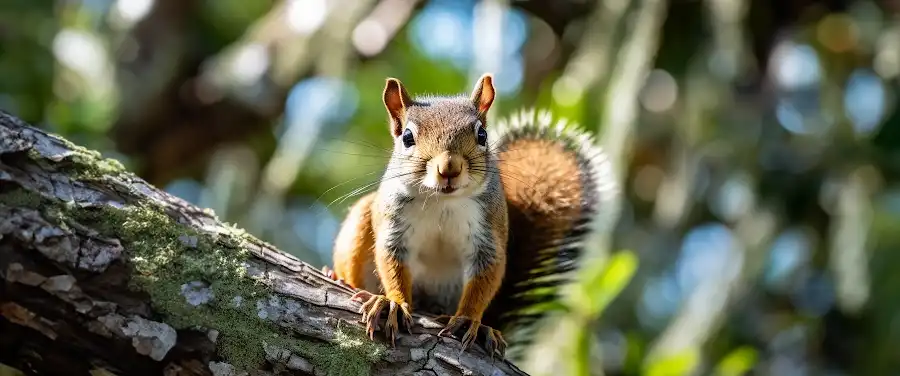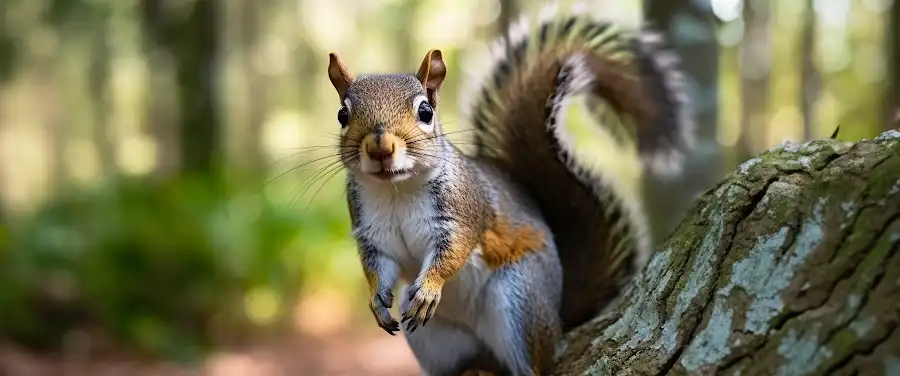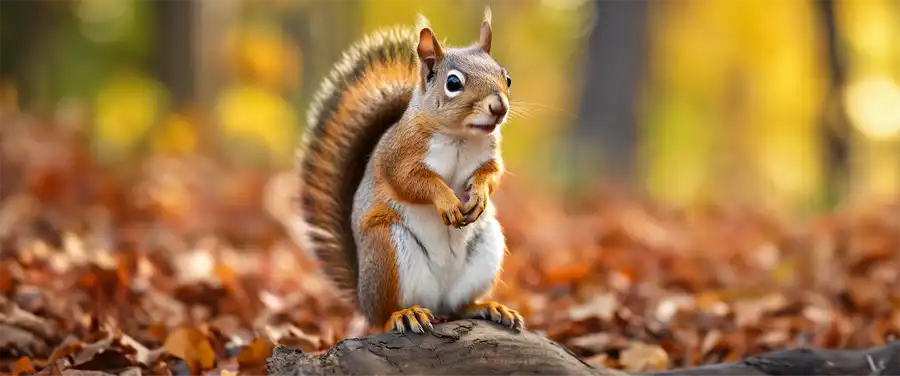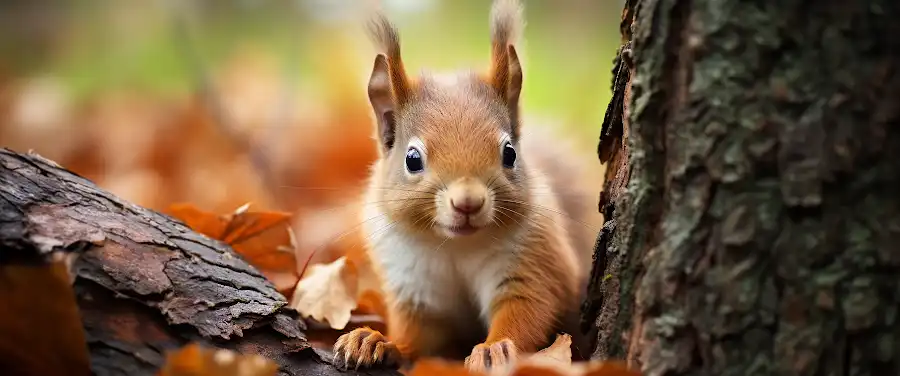
Welcome to the wild, beautiful world of Central Florida, where a wide range of creatures thrives in its diverse ecosystems. Central Florida’s wildlife cast is remarkable; from the delicate dragonflies that dance across the surface of lakes to the alligators that glide stealthily through the marshes. In this wonderful mix, our spotlight falls on one fuzzy-tailed, acorn-loving denizen: The squirrel! Yes, those agile climbers, quick sprinters, and nature’s expert foragers we often take for granted.
Unbeknownst to many, squirrels are nature’s little engineers that keep ecosystems balanced. Their diligent digging, food caching behavior, and tree planting skills play a crucial role in fostering biodiversity, forest regeneration, and shaping our landscapes. Not only are they a delight to watch, but their undervalued ecological contribution is also worth notifying. Their multitude of species reflect Central Florida’s rich biodiverse quintessence perfectly, highlighting the fact that variety truly is the spice of life!
Besides, where else would you encounter such a myriad of squirrel species surviving and thriving in harmony? Central Florida wildlife embodies the intersection of animal species, where from the backyards to state parks, each day unfolds a new story of Mother Nature’s ongoing saga. The narrative woven here will reintroduce you to our unsung furry heroes, emphasizing how invaluable they are within their habitats. Hang tight, as we prepare to dive whiskers deep into the impressive variety of squirrels that call Central Florida home, infusing a dash of newfound appreciation for these cute critters. Next up we’ll delve into the realm of common species of squirrels found in this region—get ready to meet some truly charming characters.
What is the Role of Squirrels in Central Florida’s Ecosystem?

Let’s take a nutty dive into Central Florida’s backyard and discover the critical role that the furry, acrobatic squirrels play in the ecosystem. Ever noticed how squirrels are often seen buried in the flicks of seeds or walnuts? Well, this activity has more to it than meets the eye.
The squirrels, with their habitual hoarding of seeds and nuts, inadvertently contribute to a process called seed dispersal. When they bury these edible items in the ground and forget about some, these forgotten treasures germinate into new plants. This act of forgetfulness, it appears, results in the growth and proliferation of plant species. Quite a green thumb for such small creatures, wouldn’t you agree?
But that’s not all. Squirrels, especially the ones found in Central Florida, serve a tasty treat for various predators in the food chain. In essence, they hold a critical position in the ecosystem by acting as a vital link between carnivores and the environment.
This realistic and yet somewhat harsh role in the food chain is horridly beautiful, forming an integral loop – a circle of life if you might say, where their existence is crucial yet impermanent. It provides a balance that nature so seamlessly maintains.
Moreover, squirrels contribute to soil aeration. Their digging habits introduce more oxygen into the soil, promoting the health of microorganisms necessary for rich, healthy soil.
Here’s a tabular representation of the three fundamental roles squirrels play in Central Florida’s ecosystem:
| Role | Description |
|---|---|
| Seed Dispersal | Squirrels forget some buried seeds that germinate & grow into new plants |
| Food Chain | Serve as a source of food for various predators |
| Soil Aeration | Their digging habits introduce oxygen into the soil, promoting the health of soil microorganisms |
According to a study conducted by the Journal of Mammalogy, removing squirrels from the ecosystem disrupts these ecological processes.
To sum it up, the little yet hardworking squirrels play quite a big game in Central Florida’s ecosystem. From dispersing seeds to injecting life into the soil, these small creatures are examples of some significant ecological warriors.
Now that we’ve delved into the critical role squirrels play in the ecosystem, let’s move onto identifying these acrobatic wonders. Go on, scroll ahead! How can you identify different squirrel species?
How Can You Identify Different Squirrel Species?

When you’re exploring Central Florida’s rich wildlife scene, the sight of nimble critters playfully zipping through vegetation can be quite fascinating. But did you know that Central Florida is home to an impressive diversity of squirrel species? Yes, indeed! And for those eager to connect more deeply with nature, learning how to identify these enchanting creatures can be quite exciting. To aid in your creature identification quest, you should focus on three key features: size and color, behavioral traits, and their habitats.
Firstly, size and color play a crucial role in differentiating between squirrel species. For instance, fox squirrels possess a larger body frame and display more variations in fur color compared to their counterparts. Their fur ranges from a rich, brownish-black to a lighter palette of gray and orange shades.
Secondly, the unique behavioral traits of each species also give them away if you’re looking closely. Eastern gray squirrels, often seen foraging on the ground, are known for their tendency to hide acorns for later consumption. Flying squirrels, on the contrary, engage in a more outbound style of life, gliding from tree to tree in search of food.
Lastly, the characteristics of their habitats are also telling signs. For example, fox squirrels prefer open woodlands and pine forests, while the Eastern gray squirrels frolic in a wider range of habitats, including deciduous forests, parks, and residential backyards.
What Are the Differences Between Eastern Gray, Southern Flying, and Fox Squirrels?
To deepen your understanding of Florida’s squirrel diversity, let’s delve into the nuances among three predominant species found in the region: the Eastern Gray Squirrel, the Southern Flying Squirrel, and the Fox Squirrel.
Squirrel comparison can be drawn on physical features, diets, and habitats, casting each species in a light of its own.
Comparison of physical features
The Eastern Gray Squirrel, as the name suggests, predominately wears a coat of gray fur and boasts a white underbelly. Its body can stretch between 17 to 20 inches long, tail included. The Southern Flying Squirrel presents a contrasting picture: it is much smaller at around 10 inches in length and features a soft, brown-gray fur that helps it blend into the night sky – their preferred time of activity. The Fox Squirrel, the largest of them all, flaunts a length of around 27 inches and carries a fascinating array of fur color mixes.
Comparison of Habitats
The Eastern Gray Squirrel has adapted to the presence of humans and thrives in a variety of environments, including parks and yards. Of the three, it is the most likely squirrel you’ll come across on your daily walks around Central Florida. The Southern Flying Squirrel prefers a more secluded life, inhabiting mature forests. Contrarily, the Fox Squarrel generally resides in open woodlands and pinelands.
Comparison of Diets
While all squirrels are omnivores at heart, the Eastern Gray Squirrel has a diet mainly consisting of nuts, seeds, buds, and fruits. The Southern Flying Squirrel enjoys a varied menu of seeds, insects, fungi, and even bird eggs. The Fox Squirrel prefers a menu of plant-based items, with a garnish of occasional insects.
As the diversity of nature unfolds across the Central Florida green landscapes, the role of the humble squirrel in maintaining ecological balance is indisputable. With that, let’s transition into the subsequently concerning question: What are the main threats to squirrels in Central Florida?
What Are the Main Threats to Squirrels in Central Florida?

In the heart of Florida, amid the lush greenery of its parks and forests and the suburban neighborhoods, thrives a diverse species of small and lively mammals: squirrels. However, the lively nature of these playful critters often overshadows the perilous challenges they face daily. These little fellas, vital cogs in the ecosystem wheel, are contending with an escalating barrage of threats — habitat destruction, predation, and various diseases and parasites.
Habitat Destruction
Primarily, the most acute threat is habitat destruction. Economic development and urban expansions are not only carving into the natural world but also fragmenting the squirrels’ dwelling spaces, leading to a reduced capacity for their survival. In central Florida, vast expansions of human infrastructures such as roads and buildings have transformed pockets of woodland into isolated islands, limiting the squirrels’ ability to migrate in search of food and mates.
Predators
Another looming threat to these energetic critters is predation. Squirrels often fall prey to a variety of predators – from owls and hawks in the sky to snakes and bobcats on the ground. Their competition with these predators becomes more severe as their habitats shrink and their access to food resources becomes more constrained.
Diseases and Parasites
Finally, diseases and parasites compound the accumulating threats to squirrels. From tick-borne infections to mange caused by mites, these health hazards pose a considerable challenge to the resilience of squirrel populations in Central Florida.
How Are These Threats Impacting Squirrel Populations in Central Florida?
All these challenges are converging to exert a significant strain on squirrel populations in Central Florida. The disruption of their habitats, combined with increased predation and disease susceptibility, is contributing to a worrying downward trend in their numbers.
Impact on Squirrel Population Numbers
A decline in their population could induce a ripple effect through the wider ecosystem. Squirrels play a crucial role in seed dispersion, facilitating the growth of a variety of plant species. Their decline could hamper the regeneration of forests and potentially tilt the balance of the local environment.
Consequences for the Ecosystem
Moreover, Central Florida’s ecosystems can be affected by these changes. These critters are a key source of food for multiple predators. Hence, the decline in squirrel populations could impact other species in the food chain, exuding intense ramifications across the ecosystem. They also perform a critical role in soil aeration which aids in maintaining a healthy forest floor.
In the face of these grim realities, the subsequent section sheds light on hopeful conservation initiatives in place to ensure the survival of squirrel species in Central Florida.
Conclusion
With its diverse wildlife, Central Florida is a unique place where you can find quite a few different types of squirrels scurrying about. We hope this article has quenched your curiosity and shed light on the varieties of squirrels found in Central Florida – from the recognizably adorable Eastern Gray Squirrel, the small yet mighty Southern Flying Squirrel to the less common but equally fascinating Fox Squirrel.
Each of these squirrel species contributes to the richness of Central Florida’s biodiversity in its own way. It’s important to appreciate these creatures for their integral role in our ecosystem. Whether it’s through seed dispersal, which aids in forest growth or being a food source for predators – every squirrel has a role to play.
However, it’s equally essential for us to come forward and do our part to protect these fascinating creatures. Conservation efforts are necessary to ensure these squirrels continue to thrive. While wildlife organizations are doing their part, they can’t go it alone.
So, here’s a call to action for you! You can contribute to the protection of these squirrels in a variety of ways, from participating in local conservation programs, learning more about these animals, to spreading the word about their significance. Every little effort can go a long way towards these critter’s survival.
To sum it up, our backyards are a lot more interesting than we realize! Let’s do our part to ensure that remains the case for generations to come.
| Type of Squirrel | Appearance | Habitat | Unique Features |
|---|---|---|---|
| Eastern Gray Squirrel | Medium-sized; gray fur | Parks, forests, urban areas | Adaptable to human populations |
| Southern Flying Squirrel | Small; gray-brown fur; large eyes | Wooded habitats | Has a skin fold for “flying” |
| Fox Squirrel | Large; varies in color from brown-gray, black, to almost white | Mixed woodlands | Can have varying color patterns |




